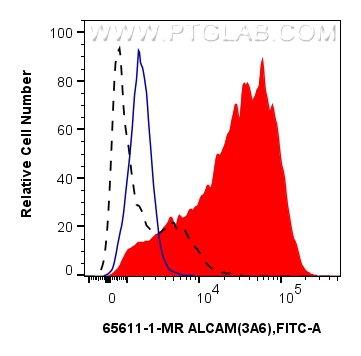验证数据展示
经过测试的应用
| Positive IF/ICC detected in | hTERT-RPE1 cells |
| Positive FC detected in | PHA treated human PBMCs |
推荐稀释比
| 应用 | 推荐稀释比 |
|---|---|
| Immunofluorescence (IF)/ICC | IF/ICC : 1:500-1:2000 |
| This reagent has been tested for flow cytometric analysis. It is recommended that this reagent should be titrated in each testing system to obtain optimal results. | |
| Sample-dependent, Check data in validation data gallery. | |
产品信息
65611-1-MR targets ALCAM in IF/ICC, FC applications and shows reactivity with human samples.
| 经测试应用 | IF/ICC, FC Application Description |
| 经测试反应性 | human |
| 免疫原 | Cultured human thymic epithelial cells 种属同源性预测 |
| 宿主/亚型 | Mouse / IgG2a |
| 抗体类别 | Recombinant |
| 产品类型 | Antibody |
| 全称 | activated leukocyte cell adhesion molecule |
| 别名 | MEMD, CD166, 3A6 |
| 计算分子量 | 105 kDa |
| GenBank蛋白编号 | BC057809 |
| 基因名称 | ALCAM |
| Gene ID (NCBI) | 214 |
| RRID | AB_3670358 |
| 偶联类型 | Unconjugated |
| 形式 | Liquid |
| 纯化方式 | Protein A purification |
| 储存缓冲液 | PBS with 0.09% sodium azide , pH 7.3 |
| 储存条件 | Store at 2-8°C. Stable for one year after shipment. |
背景介绍
Activated leukocyte cell adhesion molecule (ALCAM, also known as CD166) is a cell adhesion molecule that belongs to the immunoglobulin superfamily. It is involved in cell-cell adhesion through homophilic and heterophilic (to CD6) interactions. ALCAM is widely expressed in a variety of normal tissues and cell types, including activated T cells and monocytes, epithelial cells, fibroblasts, neuronal cells, hepatocytes, and bone marrow mesenchymal stem cells (PMID: 7760007; 25221999). Altered ALCAM expression has been associated with the differentiation state and progression in some neoplasms including melanoma, prostate, colorectal, and breast cancers (PMID: 20461761; 18172759).
实验方案
| Product Specific Protocols | |
|---|---|
| IF protocol for ALCAM antibody 65611-1-MR | Download protocol |
| Standard Protocols | |
|---|---|
| Click here to view our Standard Protocols |

